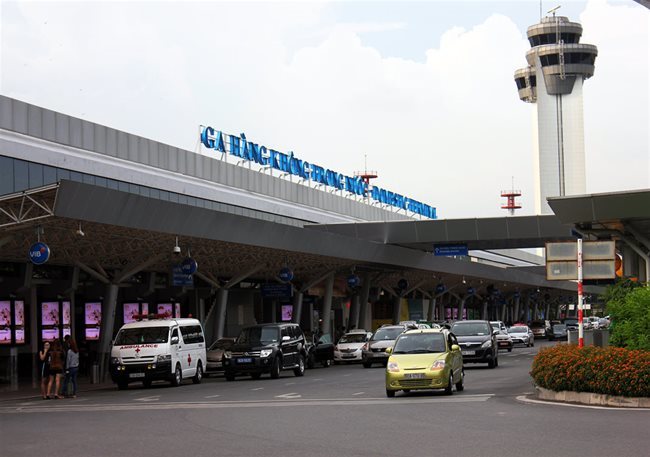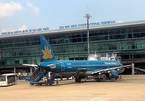It seems the order of traffic is already a reason left behind to give way to the precondition called “commercial airport right.”

Tan Son Nhat Airport
As mentioned, this is not the first time passenger transport services were bogged down at airports. Years ago, traditional taxi companies experienced similar problem when they struggled desperately to get equal access to airports to serve passengers alongside airport taxis. We had gone through a couple of peaceful years, until the collection of the airport entrance and exit fee came up, prompting the Government Inspector to step in and draw a conclusion. The regulatory fee has been kept stable for about two years now when another problem emerges: vehicles dispatched by ride-hailing apps are only allowed to enter the passenger pick-up lane like traditional taxis and other means of transport if they pay the units in charge for “commercial airport right” or “commercial airport freedom.”
Where is "commercial airport right"?
In fact, "commercial airport right" is a common concept in international practice that refers to the right of air carriers to operate air transport services. In the relationships via domestic flight supply, such right seems to be gradually made known through the explanations of airport operators.
Simply put, commercial right at an airport is in the hands of its operator. Those partners who wish to obtain the right to enter the airport to do business and provide services (non-aviation ones) have to pay a fee.
More specifically, although it never mentions the word “commercial right,” Circular 17/2016/TT-BGTVT cited by airports does provide for the cooperation in the supply of non-aviation services in this manner (Article 80.3 (b)). After two amendments to this circular in 2018 and 2020, this provision is still valid.
To make it easy to understand, just take a look at the shops at airports, especially the duty-free ones, and we shall think of the fee for airport freedom as a kind of rent for commercial premises, similar to those applied at shopping malls.
For transport services, however, such fee is not easy to identify.
When taking a flight, every passenger is charged for ground services. This is noticeable if you fly somewhere during this Covid-19 pandemic in the economy class of a certain airline. Apparently, the cost of each flight is the price of airport freedom, since the fare paid for the flight service of air carriers is already near zero, and yet the fee for operation at airports still has to be paid in full. Therefore, passengers who step into an airport after their flights land have the right to access transport services to go home. In other words, they have the right to use the roads, including internal roads, for travel.
And these roads are to be paid for.
That is why most airports do not allow passenger pick-up vehicles to park inside their premises. Instead, at quite a few airports, vehicles can only pull up (within a short time) to pick up and drop off people.
That doesn’t mean there is no parking space at airports. Parking lots are only an example. However, what this article wants to emphasize is, to “sell” commercial right, airports need to build a parking lot (for taxis), and transport companies only have to pay a fee if they are given access to such parking lot.
In fact, to maintain order, to limit vehicle traffic and offset the cost of developing and operating this special form of traffic projects, the airport entrance and exit fee is formulated. Naturally, “reasonable” is a prerequisite for determining such a fee. All vehicles, personal or commercial, are equal in the obligation to pay this fee, except for public transport. Bus stops and train stations are even located in the priority lanes and areas at each airport terminal, where passengers find it most accessible.
Ignoring the “freedom” factor (since there is virtually none, in case of normal traffic), it is not reasonable to discriminate between personal vehicles and taxis. It is not right to slap (extra) fees on traditional taxis and those operated by app-based ride services on grounds they are doing business, for they are already paying the State (taxes) for their business and have the obligation to pay the State only.
Again, there would be no controversy if the fee for airport commercial right was collected based on parking space. Meanwhile, if vehicles of ride-hailing services need no parking space, just circulating normally and stopping (not parking) to pick up/drop off passengers, then why do they have to pay the fee?
Are there any improvements?
Noticeably, since the day vehicles managed by ride-hailing apps were relocated, the pick-up-drop-off lane for traditional taxis has been somewhat more spacious. That is simply because the number of passengers using ride-hailing services now have to go elsewhere. The outcome would probably be the same, had the ones that were relocated been traditional taxis.
However, that does not mean the use of taxi services is really orderly at present. As most passengers have the habit of queuing “horizontally” while waiting for a cab, the jostle for a ride at the pick-up point proves even more chaotic when several flights land at the same time, due to a lack of options.
This was still the case even a few days after the news about traditional taxis no longer available for short trips. Once, the author upon catching a taxi cab after his flight landed at Tan Son Nhat was immediately asked by the driver about his destination before this man decided whether to provide service. What’s most impressive is the way taxi drivers may casually charge a specific rate according to one’s “destination” without relying on the meter.
That said, it is undeniable that traditional taxi companies are faring well lately. Whereas a number of passengers are patient enough to climb the stairs or walk all the way to the main road to catch a vehicle sent by app-based ride services, many others feel discouraged and opt to use traditional taxis.
How long will this situation go on? Do ride-hailing service providers feel content with the inconvenient pick-up point? Are they willing to pay parking fees or pay for airport freedom? Will airport operators make adjustments themselves or still have to charge ride-hailing apps on the circulation of their vehicles?
Viewed from Competition Law
Needless to say, airport commercial right is a proprietary practice. For that reason, the entities in charge of this product and airport operation must practice prudence with any action they take, or else it would be a violation of the Competition Law.
The most important decision in this incident is to “expel” vehicles of app-based ride services to the parking lot of TCP. There, these vehicles are forced to use the parking service even though they do not really need it. What’s more, the tier 1 package is up to VND25,000 for the first 90 minutes of parking, with the VND10,000 airport entrance and exit fee included. Such conversion of the airport entrance and exit fee not only contradict the reality and the objective of operation at airports as mentioned above, but also force ride-hailing service providers to pay an extra VND15,000 for a service they have no need to use.
If the authority of Tan Son Nhat International Airport is the one behind this decision, such action may be accused of violating Article 8 of the Competition Law. First, this unit practices discrimination between different businesses. Second, they may be said to have “obliged, required or recommended businesses to purchase certain products or use certain services.”
Meanwhile, if this is a business decision made by a business entity appointed as the airport operator, their action may be considered a breach of one of the provisions of Article 28, such as restricting service supply, limiting the market, or preventing other businesses from expanding the market. What’s more, asking ride-hailing service providers to sign a contract and pay for airport freedom may be seen as “requiring other businesses or customers to accept obligations not directly related to the subject of the contract, resulting in or potentially resulting in preventing them from joining and expanding the market or eliminating them.”
Aside from the irrationality of the fee policy, the new decision has clearly created inequality between enterprises. Moreover, it limits the right of passengers to access products and services, and it goes without saying this situation needs to be resolved as soon as possible.
However, before we can conclude whether the airport operator’s unilateral action goes against the Competition Law or not, this matter must be scrutinized by the National Competition Committee, an agency which, unfortunately, has not been established.
SGT

Tan Son Nhat Airport to perform traffic separation from November 14
The Ho Chi Minh City Department of Transport will begin to perform traffic separation in front of arrival and departure terminals at Tan Son Nhat International Airport from November 14 according to a proposal of the airport.